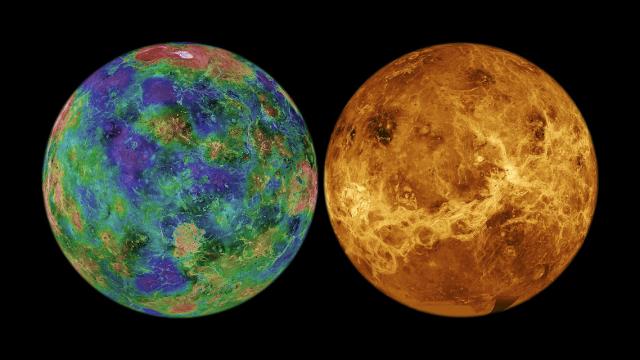After decades of neglect, Venus might just be making a comeback. Late last month, NASA announced five finalists for the next low-cost space probes; two of them are missions to Venus.
Venus has captivated our imaginations for centuries, and Cold War-era exploration of the planet brought about a lot of firsts in the history of spaceflight. But over the past 40 years, interest in our nearest neighbour has languished. NASA hasn’t had sent a dedicated probe to Venus since 1989. And the most recent Venus lander was a Soviet spacecraft that touched down in 1982.
We’ve had many a memorable trip to Venus, but the tempestuous world still harbours a lot of secrets. Let’s explore the milestones we’ve hit and the science we’ve accomplished while probing this hellish greenhouse sauna. Then we’ll discuss why it’s time to go back.
Sputnik 7: First Failed Launch From Orbit
Trying anything new in space always begins with a memorable false start or three. The very first attempt to go to Venus was USSR’s Sputnik 7 mission, which blasted off from the Baikonur Cosmodrome on 4 February 1961. Notably, this was also humanity’s first bid to launch a probe from Earth’s orbit.

A stamp printed by the USSR in 1961 to commemorate the new Venus exploration program. Image Credit: Wikimedia
Sputnik 7’s payload consisted of an orbital launch platform and the USSR’s very first Venera probe. Once in orbit, the rocket’s fourth stage was supposed to propel Venera toward Venus, but ignition failed, probably due to an electrical issue in the guidance system. Acknowledging the faulty launch would have been rather embarrassing, so instead, the Soviet government announced that Sputnik 7 was a test of an Earth-orbiting platform from which future spacecraft could be launched.
So, I guess you could say this was the first botched interplanetary coverup, too. [Source, Source]
Venera 1: First Planetary Flyby
On 12 February 1961 — not two weeks after Sputnik 7’s failure — the Soviet Union successfully launched the Venera 1 probe. As Venera 1 sailed away from Earth, it sent back data on the solar wind and cosmic radiation, offering the first scientific verification that charged particles from the Sun are present throughout deep space. Alas, three weeks later and 7.5 million kilometres (4.7 million miles) from home, Venera 1 lost radio contact with the Earth.
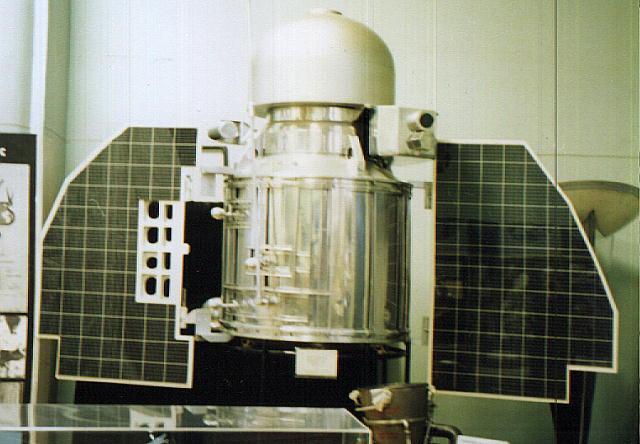
Venera 1, the first probe to fly past Venus. Image Credit: NASA
On 19 May 1961, Venera 1 sailed past Venus, marking humanity’s first (albeit silent) planetary flyby. [Source]
Mariner 1 and Sputnik 19: Rockets are Hard
The next two missions to Venus — NASA’s Mariner 1 probe and the Soviet Union’s Sputnik 19 — were both spectacular failures. Mariner 1 veered sharply off course during launch, forcing NASA to relay a self-destruct command lest the probe crash into a shipping freight or town. A month later, Sputnik 19 made it to orbit, but there, the rocket’s escape stage failed to launch. The probe gently lost altitude over the next three days, eventually burning up as it re-entered Earth’s atmosphere.
Rockets are hard. It’s a lesson we learned early and haven’t forgotten. [Source, Source]
Mariner 2: Venus Ain’t No Tropical Paradise
Not long ago, humans imagined that beneath those impenetrable clouds, Venus might actually be a lush, tropical paradise, similar to Earth during the Carboniferous period. This idea was championed by chemist Svante Arrhenius, who in 1918 decreed that “A very great part of the surface of Venus is no doubt covered with swamps.” (Arrhenius is better known for his more accurate contributions to the field of thermodynamics, and for predicting in 1896 that carbon dioxide would cause global warming.)
Science fiction writers of the late 19th and early 20th century populated the Venusian surface with all manner of exotic life forms, from dinosaurs and lizard-men to intelligent carnivorous plants.
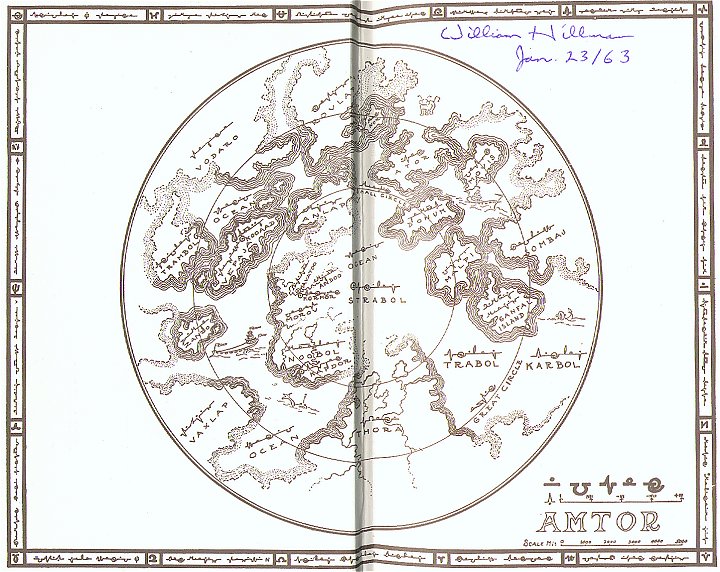
Map of Amtor, the fictionalized version of Venus with oceans and intelligent beings described in Edgar Rice Burroughs’ “Venus Series”. Image via Wikimedia
But NASA’s first successful planetary mission dashed our dreams of a liveable Venus. Launched on 27 August 1962, the Mariner 2 probe ferried a microwave and an infrared radiometer to Venus with the express purpose of determining the planet’s temperature, atmospheric composition and cloud cover. Unlike the Venera 1, its comm system didn’t crap out along the way.
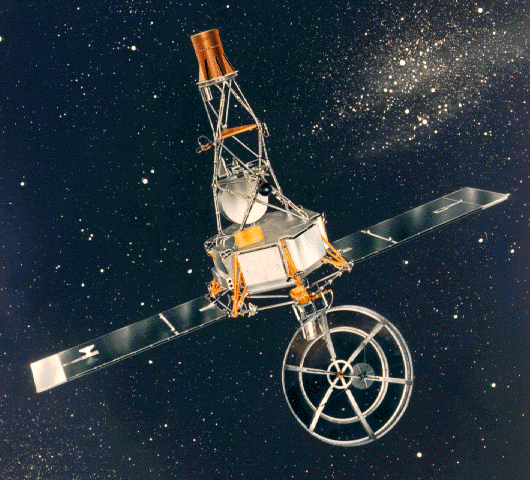
The Mariner 1 probe would have been the United State’s first probe to Venus, but it didn’t even leave our atmosphere. Image Credit: NASA
In December of 1962, Mariner 2 cruised past Venus, coming within 34,773 kilometres (21,607 miles) of the planet at closest approach. The flyby lasted only 45 minutes, but that was long enough to learn the truth: Venus is a noxious oven. Mariner 2 revealed a planet with an atmosphere full of carbon dioxide and a surface hot enough to melt lead. We also learned that Venus has a very weak magnetic field at best, meaning it’s probably bombarded with intense radiation.
So much for vacation prospects. [Source]
Venera 3: First Time Crashing on Another Planet
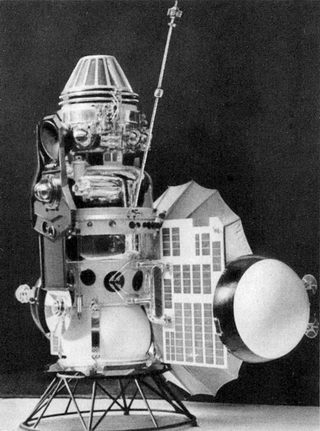
Once the Soviets had (sort of) gotten the hang of flying probes past planets, they were naturally eager to start crashing probes into planets. The Venera 3 probe became the first piece of human technology to touch the surface of another world, slamming majestically into Venus on 1 March 1966. Unfortunately, the comm system failed (again!) before any planetary data could be returned.
The Venera 3 probe. Image Credit: NASA
Too soon, the intrepid craft was nothing but a gooey puddle of scientific instruments and U.S.S.R. medallions. [Source]
Venera 7: First Time Phoning Home From Another World
Third time’s a charm? Venera 7 was the USSR’s third attempt to land a probe on the Venusian surface, and the first lander that actually worked the way it was supposed to — albeit briefly. As Venera 7 parachuted down to the surface of Venus on 15 December 1970, its antenna extended and the probe began transmitting signals back to Earth. Alas, it was a short-lived phone call. Six minutes into its descent, the parachute ripped, sending the probe into free fall for another 29 minutes. When Venera 7 impacted the surface of Venus at nearly 64 kilometres per hour, it squeaked out a brief swansong — a mere second of transmission — before falling silent forever.
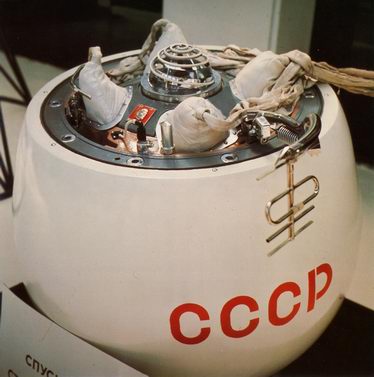
The Venera 7 probe. Image Credit: NASA
Still, that fleeting second of communication afforded the ill-fated Venera 7 a high distinction: It’s the very first spacecraft to return data from the surface of another world. Venera 7’s sensors recorded a temperature of 475 Celcius (887 Fahrenheit), a pressure of roughly 90 atmospheres, and mild winds. In case there were any lingering doubts, this mission dispelled them: Venus is Hell.[Source]
Mariner 10: First Time Pulling a Gravity Assist and More!
A gravity assist is this neat manoeuvre in which a spacecraft uses the kinetic energy gained of a planet’s gravitational tug to slingshot off into space at a higher speed. Gravity assists have featured prominently in our exploration of the solar system at large — both of the Voyager probes both used the manoeuvre to gain velocity on their journeys to the outer planets, and the New Horizons spacecraft was able to shave a full three years off the trip to Pluto by snagging a boost from Jupiter.
http://gizmodo.com/how-did-we-get…
Humanity’s very first gravity assist involved Venus, and a little probe known as Mariner 10.

The Mariner 10 probe. Image Credit: NASA
The Mariner 10 probe, which launched from Cape Canaveral, Florida on 3 November 1973, hit a lot of space exploration milestones. It was the first probe to visit two planets — Venus and Mercury — and to deliver the first close-up images of both. It was also the first probe to visit Mercury, period. And when the spacecraft passed Venus on 5 February 1974, it became the first to snag a gravity assist.

A 1975 artist’s rendering of Voyager after encountering Jupiter and, after a gravity assist, approaching Saturn. The Voyager probes, both of which used gravity assists to travel to the outer solar system, were advanced versions of the Mariner 10 probe. Image Credit: NASA / JPL
In other noteworthy achievements, Mariner 10’s scientific data found a Hadley-cell circulation pattern in Venus’s atmosphere — similar to the atmospheric circulation pattern here on Earth. Mariner 10 also offered evidence that Venus does have a weak magnetic field, and that the planet’s ionosphere interacts with the solar wind to form a bow shock. [Source]
Venera etc: We Melted A Lot More Probes and Did More Science

Surface of Venus as seen by the Soviet Venera 14 lander, which touched down in 1982. Image Credit: Russian Academy of Sciences / Ted Stryk
Once the USSR showed that brief communication from the surface of Venus is possible, the Soviets couldn’t get enough of it. Between 1972 and 1984, the USSR put nine landers — Veneras 8 through 14, and descent modules from Vega 1 and 2 — on Venus’ blazing surface. After a short period of data transmission (typically about an hour), each of these spacecraft suffered the same crushing fate.
Here are some of the critical findings from the deluge of Venera landers:
- We confirmed that Venus is a pressure cooker, with a surface temperature of 470 – 485 Celcius (878 – 905 Fahrenheit) and pressure of roughly 90 Earth-atmospheres (H/T Veneras 8 & 9)
- Venus’ cloud layer is roughly 30 – 40 kilometres (19 -25 miles) thick, with cloud bases hovering 30 kilometres high. These clouds are effused with an array of acrid poisons, including hydrochloric acid, hydrofluoric acid (used to dissolve quartz), bromine, iodine, sulphur, chlorine, and carbon monoxide. Lovely. (H/T Veneras 8, 9, 11, 12)
- The surface of Venus is littered with loose regolith, including flat, thin, angular rocks and lava. A sample collected and analysed by Venera 14 was found to be similar to terrestrial oceanic tholeiitic basalts. Later, a surface sample collected by Vega 12 was identified as anorthosite-troctolite. Whether these samples are representative of common rocks on Venus is still unknown. (H/T Veneras 9, 10, 13)
- As shrewd stargazers might have suspected, Venus is a rusty, orangey-brown. (H/T Venera 13) [Source]
Venera 15 and 16: Volcanoes Ahoy!
The last two Venera missions, Veneras 15 and 16, were orbiters launched in sequence in June of 1983 to map the surface of Venus using radar. Arriving in orbit around Venus four days apart, the two spacecraft imaged an area from the north pole down to approximately 30 degrees north latitude over a period of 8 months.
The Venera 15 and 16 missions were among the most ambitious attempts to date to map the surface of another planet. In surveying a large swath of Venus, these missions made a number of fascinating discoveries, including the first firm evidence of volcanoes. Today, we know that Venus is riddled with volcanoes, which could have been very active in the geologic past. Indeed, many researchers suspect that a long spell of volcanic activity is what created the noxious, carbon-filled atmosphere that blankets Venus today.
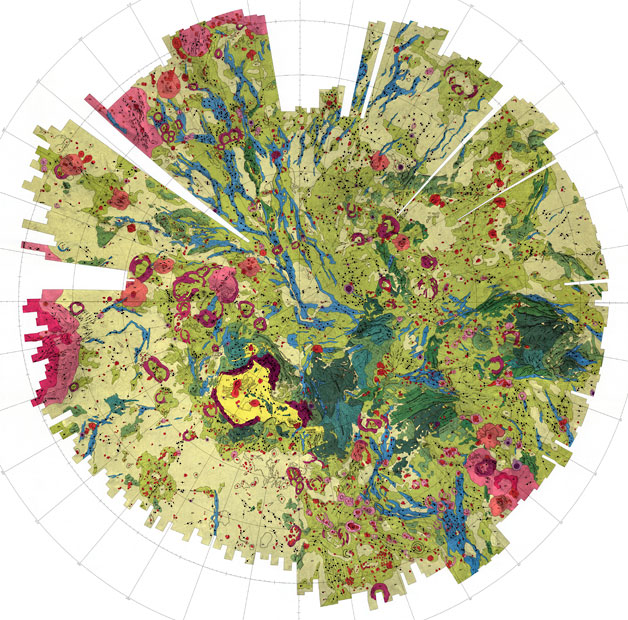
Venus’ northern hemisphere as constructed by radar data from the Venera 15 and 16 orbiters, as well as data from the Pioneer Venus orbiter and Earth-based telescopes. Light red and pink = volcanoes, purple, green and blue = mountains and ridges, yellow and green = plains. Image Credit: SPL / Barcroft Media via The Telegraph
Magellan: Goodbye, Venus
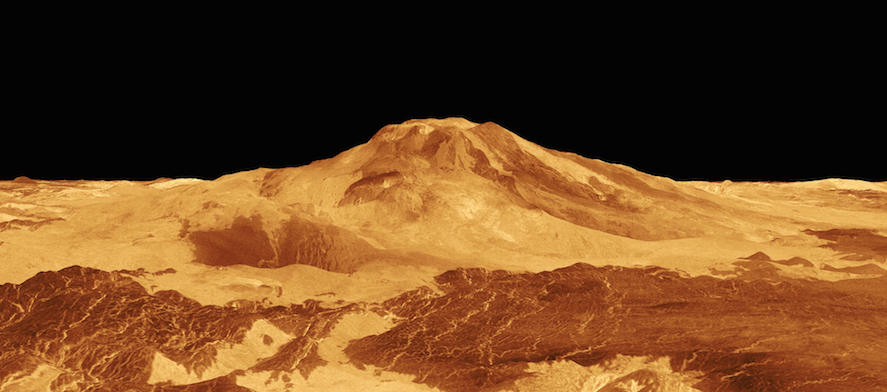
Top: A colorized radar map of the Maat Mons volcano on Venus, created by NASA’s Magellan spacecraft. Image Credit: NASA / JPL
The last dedicated US Mission to Venus was the Magellan Orbiter, launched on 4 May 1989. The primary aim of this mission was to construct a topographic map the entire surface of Venus for geologic and geomorphic studies. By the time radar mapping was finished, 98% of the Venusian surface had been detailed at resolutions better than 100 meters. While Magellan found no evidence for plate tectonic activity, the cratering pattern shown in its images told scientists that Venus’s surface is relatively young. This, along with gorgeous high-res images of lava flows, supported the notion of recent volcanic activity.
To date, Magellan’s twenty-year-old images are humanity’s best pictures of our nearest neighbour.
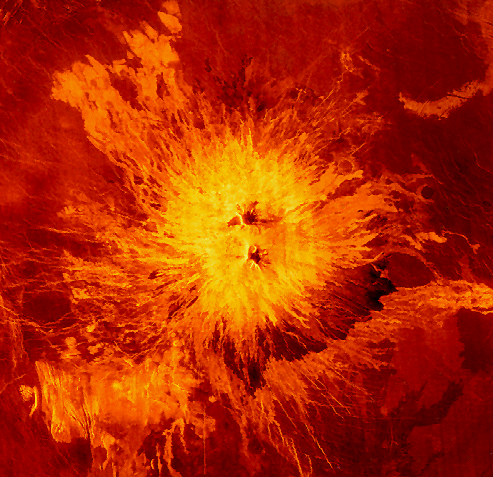
The Sapas Mons volcano is located in the Atla Regio equatorial rise. Image Credit: NASA / JPL

An unusual Venusian volcano, located on the plains between Artemis Chasma and Imdr Regio. Image Credit: NASA / JPL

A computer-generated perspective of the highland of Ovda Regio. Image Credit: NASA / JPL

Volcanic “pancake” domes, unique volcanic extrusions found on the surface of Venus that are thought to be formed from highly viscous lava. Image Credit: NASA / JPL
In recent decades, several NASA missions, including the Cassini probe (1997), and Messenger 3 probe (2004), have flown past Venus. But when we lost radio contact with Magellan in 1994, rigorous exploration of Venus by the United States effectively ended. [Source, Source]
It’s Time to Go Back to Venus
The fact that the height of humanity’s exploration of Venus occurred when the Soviet Union still existed should strike you as odd. While we lavish Mars with attention, Venus sits even closer to home, shines even brighter in the night sky, and seems all but forgotten.

Venus shines like a large, brilliant star in this gorgeous image of the Milky Way. Image Credit: ESO/Y. Beletsky
It’s easy to understand why: We learned just enough about Venus to determine that the planet is a miserable hellscape. There’s something downright disturbing about Venus’s crushing, toxic atmosphere, its broiler temperatures, its backward rotation, its wretchedly long days. Even its lack of a moon is unsettling. And so, we averted our eyes.
But really, avoiding Venus because Venus’s habitability prospects are basically nil is some shortsighted nonsense. Here’s why.
On paper, Venus is incredibly similar to Earth. It’s a rocky planet, about 5% smaller in radius and 15% smaller in mass. It’s the same age as the Earth, and receives its energy from the same star (albeit, roughy twice as much). In the past, at least, Venus was shaped by the same geologic forces that renew our planet’s surface today. Even Venus’s atmosphere and climate are disturbingly familiar: They’re the conclusion of a runaway greenhouse effect, a phenomena that the Earth will start to experience about a billion years from now if humans don’t kickstart the process much sooner.
All of which is to say, if astronomers spotted Venus orbiting a Sun-like star beyond our Solar System, it’d immediately be hailed as the most Earth-like planet ever discovered — our best shot at finding life on another world. Instead, that distinction goes to a planet some 1,400 light years away, one that’s much larger than Earth and whose basic properties are far from certain. If this distant world is Earth’s cousin, Venus is our twin. As such, understanding Venus’s fate could help us understand how likely it is for biospheres (including our own) to emerge and die.
Hang in there, Venus — we’re not done with you.
Top: Mosaic of radar images of Venus assembled using data from NASA’s Magellan Probe. Left image colour-coded to represent elevation. Image Credit: Grey Lensman / Flickr
